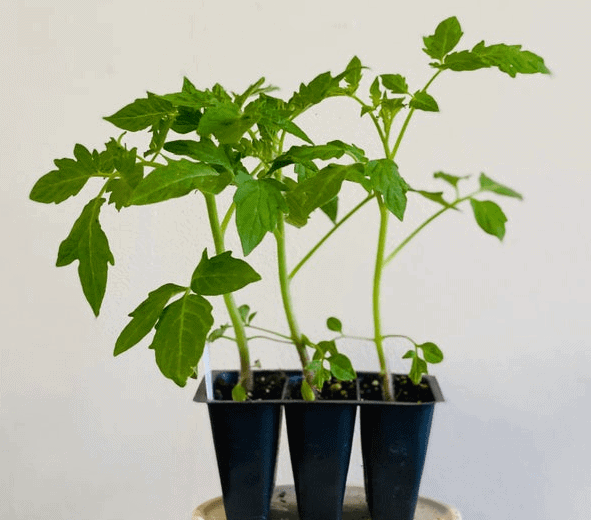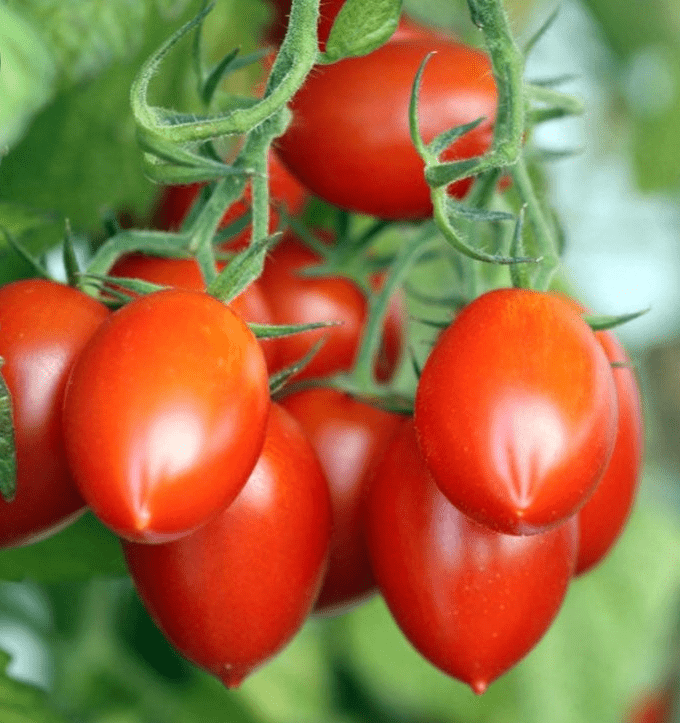While store-bought Romas tomatoes can be succulent and flavorful, there’s nothing like homegrown to have your dishes bursting with life. Whether you’re cooking up some marinara sauce or slicing up a fresh summer salad, Roma tomatoes are some of the most delicious varieties around.
These plum tomatoes are considered paste tomatoes. They have fewer seeds and a lower moisture content than others. They are easy to grow. Here I explain what the Roma tomato is and how you can grow it yourself!
Roma Tomatoes
Roma tomatoes are egg or pear-shaped tomatoes, bright red in color once ripe. Slim and firm, they are commonly used for canning, sauces, and pastes. They are determinate tomatoes which means all the tomatoes will be ready to harvest around the same time. There will be one harvest before the plant dies.
The plant grows into a bush-like shape vs vining and sprawling out like indeterminate tomatoes do. These plum tomatoes are able to mature in just a couple of months, with each plant reaching a height of about three feet.
Each Roma tomato plant is able to produce a large number of tomatoes, and every fruit weighs a couple of ounces.
History
Despite the name seeming to denote an Italian or Rome-based origin, these tomatoes are actually American. They were first created back in 1955 by the Agricultural Research Service of the USDA. It was spliced by blending parts of the heirloom San Marzona tomato from Italy and the Pan American tomato.
The Roma tomatoes we know and use today are a little different from those made back in the 50s, as the variety has been selectively bred over the years to become resistant to new bacteria and pests.
However, these tomatoes have always had that same special taste, texture, and structure, giving them a wide variety of uses, from being cooked to eaten raw. It’s easy to find Romas at the grocery store.
Uses for Roma Tomatoes
- Pastes
- Sauces
- Purees
- Relishes
- Salsas
- Ketchup
- Soups
- Stews
Roma tomatoes can also be plucked right from the vine and eaten fresh, without any cooking required. They work well in sandwiches and salads or sliced up and spread across some bruschetta, Italian-style, with a drizzle of balsamic reduction.
They tend to be most commonly-savored cooked, however, as the cooking process really helps to bring out some of the full richness and intensity of the Roma tomato flavor.
How to Grow a Roma Tomato Plant
Roma tomatoes, also known as Italian tomatoes and Italian plum tomatoes, are some of the most widely consumed plum tomatoes around. Famed for their distinctive egg shape and low numbers of seeds, these tomatoes are perfect for making pastes and sauces. They’re commonly grown in many countries around the world, including the USA, the UK, and Mexico.
This guide will tell you all you need to know about the Roma tomato, including top growing tips and step-by-step instructions for growing your own Roma tomato plant from starter plants or from seed.
Growing tomatoes in pots is ideal for smaller outdoor spaces, patios, and balconies. You can also grow them in garden beds or learn how to grow hydroponic tomatoes for year-round yields.
Option 1: Purchase an Established Plant
Your local home improvement store such as Home Depot, Lowes, Menard’s and Ace Hardware will likely have Roma tomato plants for sale. Roma plants are common tomatoes. You can also buy them from garden centers and nurseries. There are organic Roma tomato plants available as well.
You can transfer these plants into a garden bed or larger pot.
Option 2: Grow Roma Tomato Plant from Seed
You can also plant Roma tomato seeds. You can start growing Roma tomato plants inside the home or in another indoor environment, like a greenhouse. It’s recommended to get started about two months after the last frost in your area.
Steps to Grow Roma Tomatoes
- Gather all the supplies before starting off, including your seeds, some starting mix/soil, containers for your seeds and soil, and a simple spray bottle too.
- Add the soil or starting mix into your seed trays.
- Sow the seeds into the trays. Try to put about three seeds in each tray, as the odds are that some of them won’t germinate.
- Place the seeds on top of the soil, a little distance away from one another, and then sprinkle over some soil and smooth it down. You can then use the spray bottle to water the seeds gently. Just a few squirts should be enough.
- You can then move your trays to your “germination station,” which might be a greenhouse or other warm space. If you don’t have a greenhouse, the seeds can be placed under some plastic wrap near a window, helping to provide warmth and humidity.
- Make sure to regularly water your seedlings and ensure that they get enough light on a daily basis.
- Thin out any of the weaker plants to avoid overcrowding.
- Re-pot once the plants have gotten tall enough (optional).
- Once the seedlings have grown about 6 inches tall, transplant them outdoors.
You can transplant Roma seedlings to your garden once the conditions are warm enough, with night-time temperatures in excess of 50F degrees.
Growing Roma Tomatoes
It’s clear to see that Roma tomatoes have a lot to offer, so it’s no surprise that many people are eager to try growing their own Roma plants at home. You can start this process off inside your home.
Growing Romas is relatively easy, as long as you have patience, pay close attention to the conditions, and focus on caring for your plants correctly to help them grow big and strong.

Top Tips for Growing Roma Tomatoes
Here are a few more tips to help your Roma tomato plants grow once you’ve gotten through the initial seed-to-seedling stage:
- When it comes to hardening off your Roma seedlings, do so gradually. There’s no need to rush the process.
- Use plant covers to protect your plants during storms or heavy winds and rain.
- Aim to plant in soil with a pH of around 6.3/6.4.
- Use cages or stake/trellis structures to support your plants. If using a cage, set them around the plant while it’s still small.
- Sunlight requirements for these plants are up to eight hours a day. They need a minimum of six hours of direct sunlight to thrive.
- Use deep watering on growing Roma plants to avoid issues like blossom end rot.
- Use fertilizer once the flowers begin appearing.
- Make use of a mulch blend of lawn clippings and straw around the plants. This will reduce the risk of weed growth and help retain moisture.
- If you’re keeping your plants in a container, they’ll need to be fed and watered more often.
No Pruning Necessary
When growing a Roma tomato plant, you won’t need to prune or remove any suckers. Let it be. Because Roma tomato plants are determinate, there is nothing to do. The fruits will all develop at around the same time.

Harvesting
Roma tomatoes should ripen and be ready for harvesting in two to three months. It’s best to pick them when they are fully ripe so you can eat them fresh off the vine. You can pick them when they are slightly green as long as they aren’t fully firm. They will continue ripening after harvest.
Pests
If you notice some leaves from your Roma tomato plant are missing or have bite marks, you may have tomato hornworms. These are fat green caterpillars that despite their large size, are difficult to spot on tomato branches, especially because Roma tomato plants grow into thick bush shapes.
If you see a plant has damage, look right away for the caterpillars. You will likely see at least one if you look thoroughly. You can remove it by hand or with tongs. Learn how to get rid of tomato hornworms.
Deer, rabbits, javelina, raccoons, and other animals can also eat tomato plants. Protect your plants if you have them in your area.
Growing Romas in Pots, Containers, Garden Beds
Roma tomatoes are a culinary delight. They are so simple and fun to grow on your own. Kids and adults will enjoy picking them to use in salads, pastes, sauces, soups, and more. Buy some organic seeds and get started today to watch your very own Roma tomato plants grow for a summer harvest!
Learn more:

